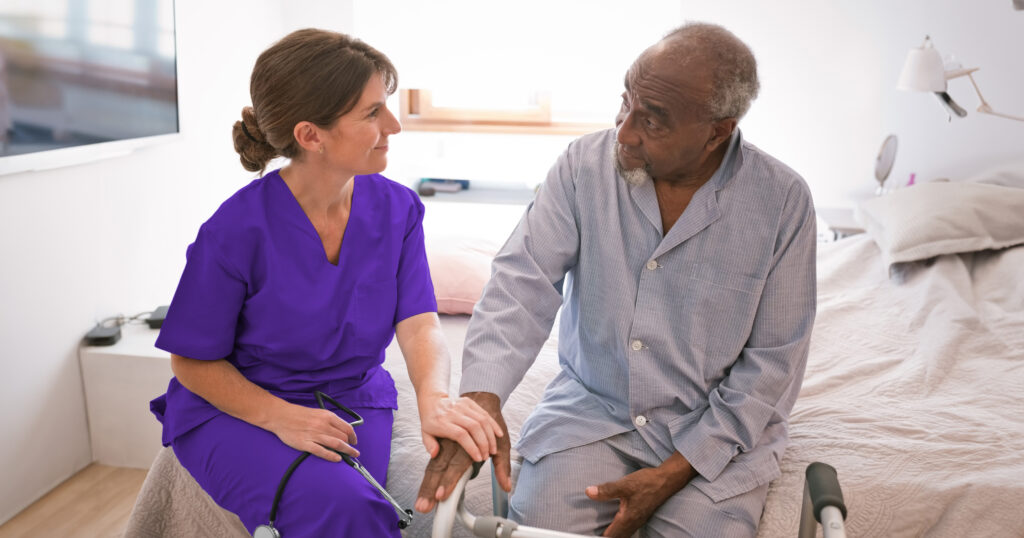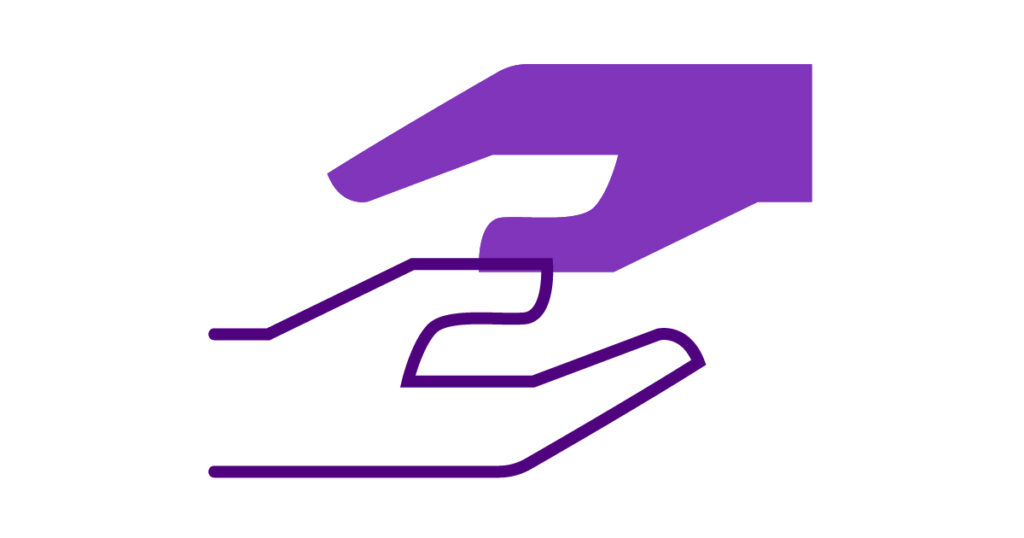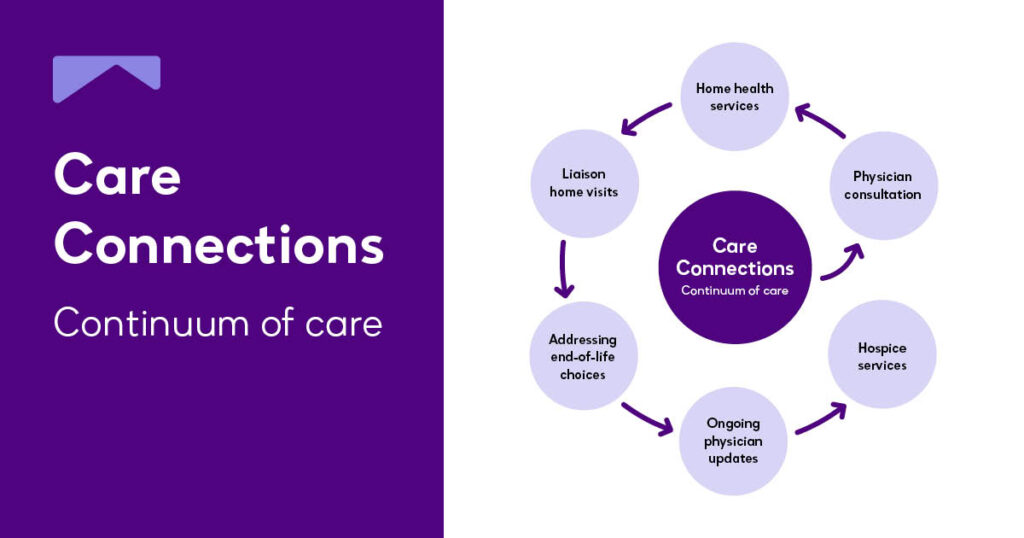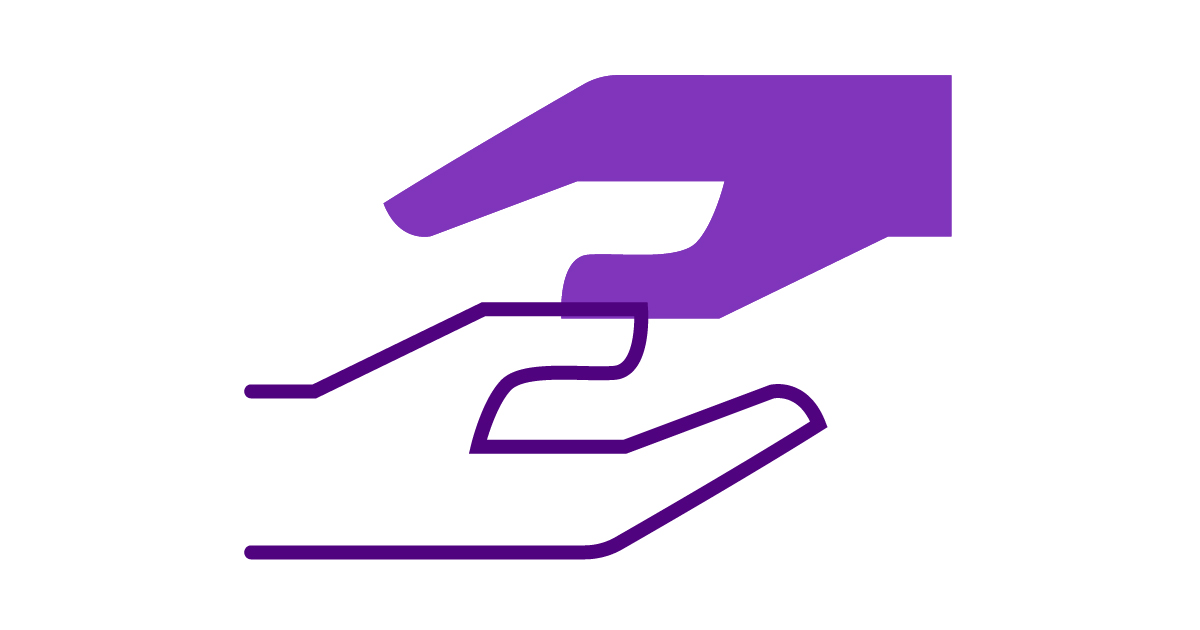Home health care and hospice care are two different services. For some, transitioning from home health to hospice care is the next step in one’s care journey.
Maybe you’re a daughter wondering what’s next for your mother’s home health care. Maybe you’re a home health patient yourself who is trying to plan for the future. Or perhaps, you’re a physician concerned about a home health patient that isn’t improving.
No matter where you are in a care journey, Enhabit Home Health & Hospice helps patients and their loved ones determine the right care at the right time. One of the ways we do that is through our Care Connections Program.

What is the Care Connections Program?
At Enhabit, our teams work together to offer a long-term solution to reducing hospital admissions and improving quality of life during the end-of-life journey through our Care Connections Program.
The Care Connections Program provides a seamless transfer of care from home health to hospice services, helping patients transition from curative to comfort care in a timely manner.
“Our goal is to empower patients to remain in control of their health care decisions at every step,” Enhabit’s Vice President of Care Transitions Kristi Wimberly said. “Our Care Connections Program allows for continuity of care and a seamless transition from home health to hospice, all while at home and surrounded by loved ones.”

Patients are eligible for the Care Connections Program if they’ve been diagnosed with a chronic disease and qualify for home health services. Patients can also be actively involved in curative therapies. Learn more about signs it might be time to transition from home health to hospice care below.
How to know if it is time to transition from home health to hospice
When facing a terminal illness, most people desire to spend their valuable time in the comfort of wherever they call home, avoiding debilitating trips to the hospital. However, many patients are referred to hospice too late or wait too long to contact a provider.
If you or a loved one are currently on home health services, have been diagnosed with a terminal illness and are experiencing any of the following signs, it may be time to transition from home health to hospice care:
- Frequent rehospitalizations
- Increased fatigue or sleeping
- Lack of appetite or weight loss
- General decline in function
- Reoccurring infections
- Unsuccessful curative care
- Chronic pain
The Care Connections Program also helps patients who:
- Are not yet appropriate for hospice care but could benefit from conversations regarding end-of-life
- Are appropriate for hospice care but are not yet willing to forgo aggressive treatment
- Have maximized their potential and can no longer achieve rehabilitation
- Have an increased need for additional emotional and spiritual support
How the Care Connections Program helps patients transition from home health to hospice
When transitioning from home health to hospice care, patients will receive specialized, compassionate care that’s consistent with their wishes.
Care Connections Program services include:
- A team of caring professionals who address the physical, psychosocial and emotional needs of patients and caregivers
- Specialty programs that take an evidence-based approach to care
- Guidance for addressing medical decisions regarding diseases or treatment plans while respecting patient’s specific health care goals
- Assistance with advance directives, DNR and medical power of attorney
- Family consultations to educate loved ones about the disease process
- Care coordination between physicians and home health team to identify why a transition to hospice may be appropriate
“The model is based on a continuum of care, starting with the physician, moving to the home health team and ending with hospice services, communicating and addressing patient needs throughout each team involved in a patient’s plan of care,” Wimberly said.

While the program is largely based on a patient’s care journey, Enhabit recognizes it can be a particularly difficult time for loved ones as well. In addition to aiding with the patient’s transition, the Care Connections Program helps families and gives them time for reflection, grieving and support.
How the Care Connections Program improves quality of life
The Care Connections Program allows patients to choose a care plan focused on comfort and dignity at the end of life. When a patient is able to receive end-of-life care that is consistent with their wishes, their last days could be more comfortable, leading to an improved quality of life.
Facilitating early conversations about hospice and end-of-life care
According to the National Hospice and Palliative Care Organization (NHPCO), over half of hospice patients are only on hospice for 30 days or less when the Medicare hospice benefit lasts for six months. Oftentimes, patients and their loved ones wish they would have known about hospice care sooner.
The Care Connections Program helps educate patients and their loved ones on the benefits of hospice and how to begin the hospice conversation. By having early conversations about hospice, patients can receive care that’s consistent with their wishes, resulting in a quality end-of-life experience for both patients and their loved ones.
“We want patients and loved ones to know all of the options available for their care,” Wimberly said. “Whenever we educate families on the benefits of hospice care and early hospice conversations, they feel empowered to receive the treatment that is best for their situation.”
Age-friendly care
As patients facing the transition from home health to hospice have particularly unique health care needs, Enhabit also incorporates elements of age-friendly care into the Care Connections Program to help increase quality of life.
Age-friendly care centers around four important pillars called the 4Ms. These include: What matters, medication, mentation and mobility. Particularly in hospice care – or when transitioning from home health to hospice – clinicians prioritize what matters most to patients and their loved ones, ensuring their care aligns with their wishes for the end of life.
Keeping patients out of the hospital
In addition to increasing quality of life by providing the right care at the right time, the Care Connections Program ensures patients can receive the level of care they need without any trips to the hospital.
Although it’s natural to pursue treatment when diagnosed with a terminal illness, patients who choose to continue interventions actually spend more time in the hospital and intensive care unit. This causes them to lose quality time with family and friends.
Transitioning from home health to hospice through the Care Connections Program helps patients gain back that quality time with loved ones, allowing them to spend their last days wherever they call home and not at a hospital.
If the time is right to transition from home health to hospice care, our Care Connections Program provides support for patients and their loved ones every step of the way.
“No matter what a patient may be going through, our Care Connections Program is there to support them and their loved ones,” Wimberly said. “Our program not only helps keep patients comfortable but works to lift the burden of care off of loved ones. This results in a less stressful experience for everyone, giving patients and their loved ones the ability to spend more quality time together at the end.”
Social Share
At Enhabit our patients are our number one priority. From providing the latest medical practices to building deep personal connections, we’re focused on upholding every patient’s dignity, humanity and sense of control on their health care journey.
Home health
Our home health services give patients access to the care they deserve in the comfort of their own homes. From disease and injury management to recovery from surgery, our clinicians help patients confidently achieve their health care goals.
Hospice care
Our hospice care services place importance on the comfort of every patient living with a terminal illness. Our caring professionals are dedicated to providing not just physical care, but spiritual and emotional support to every patient and their loved ones.






